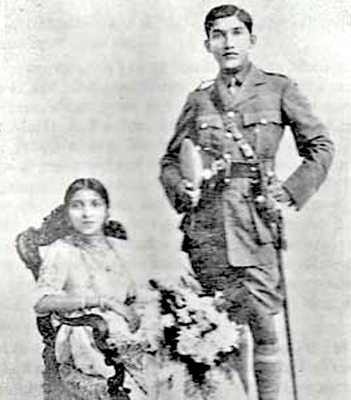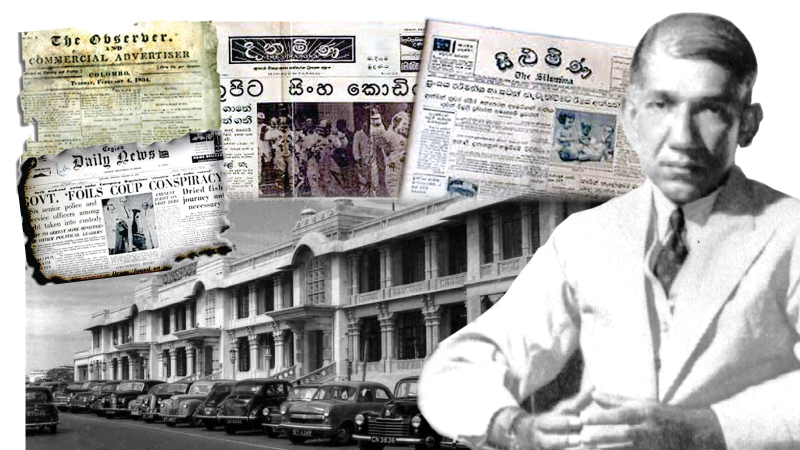 In my room at Lake House, only one picture hangs on the wall. It is that seminal portrait of D.R. Wijewardene taken by Lionel Wendt.
In my room at Lake House, only one picture hangs on the wall. It is that seminal portrait of D.R. Wijewardene taken by Lionel Wendt.
Every day, when I step into my room, I take a moment to bow before this portrait of Lake House founder Wijewardene, who almost single handedly created a publishing revolution in Ceylon, as Sri Lanka was then known. There is a bust of him in the Lower Board Room of Lake House, which will conduct a series of religious ceremonies this week to mark his 139th Birth Anniversary that falls today (February 23).
Indeed, only a few people have influenced the course of Sri Lanka’s history in the manner that Wijewardene, founder of the Associated Newspapers of Ceylon Limited (ANCL/Lake House), has done. As we commemorate his Birth Anniversary, it is time to re-evaluate his yeoman service to the Nation and to journalism. The ANCL itself will turn 100 in 2026, although many of the newspapers it publishes are much older.
Anti-colonial mission
Wijewardene will always be known as the doyen of the newspaper industry in Sri Lanka. Born on February 23, 1886, Don Richard Wijewardene was the third son of a family of nine. He received his early education at S. Thomas’ College, Mount Lavinia and later entered Cambridge University in England, where he met some leaders of the Independence Movement of India and also witnessed the power of the British media in moulding public opinion. Most British newspapers such as the Times were more than 100 years old by this time.

A wedding photograph of Mr. and Mrs. Wijewardene
His stay in the UK was a turning point in his life that inspired him to actively contribute to the Independence struggle in his native land. Incidentally, Wijewardene is also credited with rediscovering the National Flag that was brought to the ground by the British on March 2, 1815 (when they took control of the entire island), from an archival facility in London.
Wijewardene, hailing from an affluent family in Colombo, could have looked the other way and pursued his business interests while the people back home suffered under the yoke of colonialism. But he did not take that easy option. He wanted to be in the vanguard of the freedom movement and in newspapers, found the perfect medium to carry forward the freedom struggle.
Wijewardene found the right opening for his anti-colonial mission by purchasing the Sinhala publication Dinamina started by legendary editor H.S. Perera. The Dinamina, founded in 1909, had run into financial difficulties by 1914.
Wijewardene with his brother, D.C. Wijewardene bought the rights to the Dinamina and transformed it into one of the most dynamic dailies in the country.
Today, at 115 years, the Dinamina is the oldest Sinhala daily.
In 1918, Wijewardene bought an English newspaper, the Ceylonese which had also run into financial distress. He paid Sir Ponnambalam Arunachalam, its founder, Rs.16,000 (then a massive sum) for the paper, the plant and goodwill. Wijewardene revived it and renamed it the Ceylon Daily News.
This newspaper has become such an ingrained part of people’s lives that many old timers and even younger readers still call it the CDN, long after the newspaper shed the ‘Ceylon’ tag. It became one of the most influential voices in the local political scene, shaping opinions and creating debate and it remains so, having already passed its centenary in 2018. On a personal note, I had the rare privilege of becoming its Chief Editor twice.
He then purchased the Daily Observer, which was already 90 years old, having begun publishing in 1834. The Daily Observer, published in the evenings, folded around 20 years ago but the Sunday Observer, which you are reading now, is as vibrant as ever and nearing 100 years. The Daily News too was earlier published on Sunday, but this was stopped to make way for the Sunday Observer.
The Sinhala weekly Silumina was started in 1930 and the Thinakaran in Tamil followed a couple of years later, making ANCL the first trilingual publishing house in the island. It remained so for several decades, well into the 2000s.
Lake House
The ANCL was formally established in 1926 and all operations were shifted to the purpose-built ‘Lake House’ building by the banks of the Beira Lake in the heart of Colombo in 1929; hence the name ‘Lake House’. The company, the biggest newspaper publisher in Sri Lanka, still operates from this historic landmark building and the name ‘Lake House’ is now synonymous with ANCL. It is now listed as a heritage building and cannot be modified without permission from the relevant authorities.
Anyone entering the Lake House building would be thoroughly amazed to witness the skillful planning and the deft designing of the entire construction and the interior lay out. The building is constructed in such a way that any type of modern machinery and equipment can be easily installed without major alterations to the building. Under any emergency, the entire workforce can leave their desks and other places of work through the numerous exits.
Walking along the corridors one would be overjoyed to appreciate the different kinds of traditional Sinhala motifs adorning the walls.
The grills on the walls in all the floors are adorned with the design of the Dhammcakka – the wheel of righteousness. Bordering the ceiling are paintings drawn on a similar pattern to the Kelaniya Raja Maha Vihara paintings illustrating Buddhist themes.
Low-key profile
Though Wijewardene maintained a low-key profile throughout his life, his name became a household word with the ever growing readership of Lake House papers, though it was hard to find a picture of him even in his own newspapers.
Sir Ivor Jennings, an Irish Christian, the first Vice-Chancellor of the Peradeniya University of Sri Lanka commented that, “As a Buddhist he (Wijewardene) could not advocate or allow his newspapers to advocate methods of violence….”
Wijewardene, with his hand-picked team of erudite editors and journalists who shared his noble vision and mission, was in the forefront of the non-violent independence struggle through his array of trilingual newspapers. In fact, all of Sri Lanka’s leading journalists and authors have begun their careers at Lake House. Some have since moved on to other careers, but they will always admit that the ANCL laid a solid foundation for their lives.
Wijewardene saw his Independence dream being fulfilled in 1948, but unfortunately passed away just two years later on June 13, 1950, leaving a lasting legacy that will forever be etched in the minds of all Sri Lankans and in the annals of journalism in Sri Lanka. His sons are still in the newspaper business, having formed a separate company which is now the second biggest publishing company in the country. The ANCL was taken over by the Government in 1973, leading to a seismic change in the publishing business. There have been several promises to broad-base Lake House, so far without success.
Trailblazer
Wijewardene revolutionised the newspaper industry and journalism in Sri Lanka with his fearless commitment to exposing the truth through ANCL newspapers. As one of his biographers, the one-time Chief Editor of the Daily News H.A.J. Hulugalle wrote, “before he was 50, D. R. Wijewardene had established several flourishing newspapers, built up a great business and influenced the course of the island’s history.
Perseverance, courage and a high sense of public duty were the main elements of his success”.
He was a perfectionist and a trailblazer. The Lake House edifice, instantly recognised by people across the island, is a proud monument to his lasting legacy. He also installed the latest printing technology available at that time and assured a good working environment for his employees. The ANCL continues this tradition.
Wijewardene also understood the power of the visual medium and established a studio called ChitraFoto at Lake House premises where some Sri Lanka’s foremost photographers honed their skills. Although this no longer exists, Lake House has a vibrant team of photographers equipped with the latest digital cameras who continue the tradition of fine photography for the newspapers.
But journalism is not the only sector that benefited from his vision for a better country. When Sri Lanka’s first University was to be constructed in a locality that would be pleasant and second to none in Asia, Wijewardene’s advocacy for a residential University located away from all distractions of the capital city of Colombo, finally won the day and the University came up majestically in the Dumbara Valley in the hill country. Wijewardene could not live to see the accomplishment of the cause of the University he had championed. The University’s Wijewardene Hall stands as a living monument to his ideals.
He also donated his books from the Donald Ferguson Collection relating to the Dutch and Portuguese period in Lanka and all the maps he purchased in England and elsewhere. Wijewardene also bequeathed a valuable collection of books and manuscripts purchased from the Library of W.A. de Silva to the University Sangharama in Peradeniya. The Sangharamaya – a residence for the undergraduate bhikkhus of the University had been on his mind during the latter part of his life. His main objective was providing separate accommodation with all facilities provided to the bhikkus to enable them “to obtain a University education that they may be able to perform a Dhammaduta service both in Sri Lanka and in foreign lands.”
Indeed, men and women of his calibre are few and far between. While the newspaper industry has changed drastically since the 1950s, the ideals he cherished in the field of journalism still hold true. Lake House itself has embraced these changes, becoming the first company in South Asia to publish all its newspapers on the Web way back in 1994. At this time, even The Hindu and the Times of London were not on the web. It also has smart phone apps, e-papers, and mobile/Whatsapp alert services.
But this very expansion of the media landscape to include print, electronic, web and Social Media (the latter two are sometimes called “new media”) has created an environment where misinformation, alternative facts and fake news thrive at the expense of high quality journalism since all journalists and media outlets do not play by the rules governing quality journalism. Artificial Intelligence (AI) has added another intriguing layer to this mix, with AI generating completely false news headlines which some people fall prey to. This is a major challenge for institutions such as the ANCL, which is still committed to the major principles of journalism.
But one trend is inescapable – all the media are converging today and one cannot predict what the media landscape would look like even in 2030. Today, people are bombarded with news 24/7, on their mobiles, on television, radio and the Net. Truth and accuracy often become casualties of this ‘race to be first’. Falsehoods are amplified in the echo chambers of Right wing websites.
Despite these developments, reports of the death of the (printed) newspaper are greatly exaggerated. Newspapers still have a story to tell – one that is more analytical, more in-depth and assuredly more trustworthy than the sound bites and video clips of the Internet age. This is why people still turn to the newspapers to learn the real facts. Yes, newspapers will evolve and change over time but all journalists, regardless of their platform, still have to be guided by the principles that Wijewardene firmly believed in – being bold, truthful and objective – in this noble mission. And no matter what the medium is, good journalism will survive all challenges.










